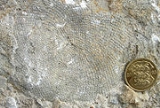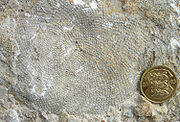
Dasycladales
Encyclopedia
In taxonomy
, the Dasycladales is an order
of large unicellular green algae in the class Ulvophyceae
. It contains two families, the Dasycladaceae
and the Polyphysaceae
.
These single celled algae are from 2 mm to 200 mm long. They live on substrates in shallow warm marine waters, usually less than 20 meters deep. They are very large cells. They are able to attain these sizes without numerous internal cell wells because they build calcium carbonate shells around themselves.
They contain only one nucleus
in their vegetative stage, which remains in the bottom of the cell in the holdfast
at the substrate. Only when they are ready to produce gametes does the nucleus undergo meiosis
and then numerous mitoses
into many nuclei which then migrate into the gametangia
at the top of the algae.
Because the nucleus is safely hidden in the holdfast, the cells easily regenerate if the top portions are broken off.
These algae are notable for having an intracellular network of 10 nm proteinaceous filaments, possibly for the storage and transport of ribonucleoprotein particles.
Because of all these properties, and the fact that they are easy to manipulate they have been favorite organisms in the study of the role of the nucleus vs the unnucleated cytoplasm
in the behavior of cells.

Taxonomy
Taxonomy is the science of identifying and naming species, and arranging them into a classification. The field of taxonomy, sometimes referred to as "biological taxonomy", revolves around the description and use of taxonomic units, known as taxa...
, the Dasycladales is an order
Order (biology)
In scientific classification used in biology, the order is# a taxonomic rank used in the classification of organisms. Other well-known ranks are life, domain, kingdom, phylum, class, family, genus, and species, with order fitting in between class and family...
of large unicellular green algae in the class Ulvophyceae
Ulvophyceae
The Ulvophyceae or Ulvophytes are class of green algae, distinguished mainly on the basis of ultrastructural morphology. The sea lettuce, Ulva, belongs here. Other well-known members include Ulothrix and Acetabularia....
. It contains two families, the Dasycladaceae
Dasycladaceae
The Dasycladaceae is one of the two families of algae of the order Dasycladales. When found in Palaeozoic limestones, they typically indicate depositional depth of less than 5m....
and the Polyphysaceae
Polyphysaceae
The Polyphysaceae is a taxonomic family of green algae, one of two families in the order Dasycladales.-Scientific databases:...
.
These single celled algae are from 2 mm to 200 mm long. They live on substrates in shallow warm marine waters, usually less than 20 meters deep. They are very large cells. They are able to attain these sizes without numerous internal cell wells because they build calcium carbonate shells around themselves.
They contain only one nucleus
Cell nucleus
In cell biology, the nucleus is a membrane-enclosed organelle found in eukaryotic cells. It contains most of the cell's genetic material, organized as multiple long linear DNA molecules in complex with a large variety of proteins, such as histones, to form chromosomes. The genes within these...
in their vegetative stage, which remains in the bottom of the cell in the holdfast
Holdfast
A holdfast is a root-like structure that anchors aquatic sessile organisms, such as seaweed, other sessile algae, stalked crinoids, benthic cnidarians, and sponges, to the substrate. ...
at the substrate. Only when they are ready to produce gametes does the nucleus undergo meiosis
Meiosis
Meiosis is a special type of cell division necessary for sexual reproduction. The cells produced by meiosis are gametes or spores. The animals' gametes are called sperm and egg cells....
and then numerous mitoses
Mitosis
Mitosis is the process by which a eukaryotic cell separates the chromosomes in its cell nucleus into two identical sets, in two separate nuclei. It is generally followed immediately by cytokinesis, which divides the nuclei, cytoplasm, organelles and cell membrane into two cells containing roughly...
into many nuclei which then migrate into the gametangia
Gametangia
A gametangium is an organ or cell in which gametes are produced that is found in many multicellular protists, algae, fungi, and the gametophytes of plants...
at the top of the algae.
Because the nucleus is safely hidden in the holdfast, the cells easily regenerate if the top portions are broken off.
These algae are notable for having an intracellular network of 10 nm proteinaceous filaments, possibly for the storage and transport of ribonucleoprotein particles.
Because of all these properties, and the fact that they are easy to manipulate they have been favorite organisms in the study of the role of the nucleus vs the unnucleated cytoplasm
Cytoplasm
The cytoplasm is a small gel-like substance residing between the cell membrane holding all the cell's internal sub-structures , except for the nucleus. All the contents of the cells of prokaryote organisms are contained within the cytoplasm...
in the behavior of cells.

External links
- Berger, Sigrid (2006).- Photo-Atlas of living Dasycladales.- ISBN 2-916733-01-9, Carnets de GéologieCarnets de GéologieCarnets de Géologie is an electronic journal that publishes in the field of geosciences, and particularly paleontology, stratigraphy, and sedimentology. The open-access journal is one of the founding members of the OA portal Geoscience e-Journals...
, Brest, Book / Livre 2006/02 (CG2006_BOOK_02), 348 p., 1 fig., 332 micrographs. - Génot, Patrick (2009).- Cenozoic Dasycladales. A photo-atlas of Lutetian species from French Cenozoic basins.- ISBN 978-2-916733-03-6, Carnets de GéologieCarnets de GéologieCarnets de Géologie is an electronic journal that publishes in the field of geosciences, and particularly paleontology, stratigraphy, and sedimentology. The open-access journal is one of the founding members of the OA portal Geoscience e-Journals...
, Brest, Special Publication 2009/01 (CG2009_SP01), 180 p., 2 figs., 29 pls.

